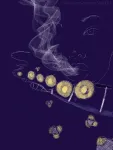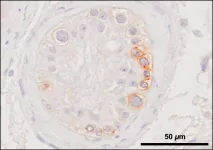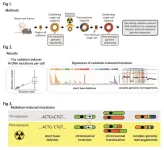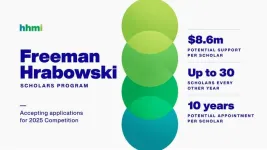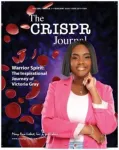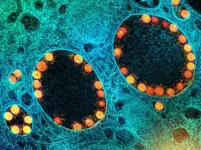(Press-News.org) A picture is worth a thousand words, as the saying goes, and research has shown that the human brain does indeed better retain information from images than from text. These days, we are taking in more visual content than ever as we peruse picture-packed news sites and social media platforms.
And much of that visual content, according to new Berkeley Haas research published in the journal Nature, is reinforcing powerful gender stereotypes.
Through a series of experiments, observations, and the help of large language models, professors Douglas Guilbeault and Solène Delecourt found that female and male gender associations are more extreme among Google Images than within text from Google News. What’s more, while the text is slightly more focused on men than women, this bias is over four times stronger in images.
“Most of the previous research about bias on the internet has been focused on text, but we now have Google Images, TikTok, YouTube, Instagram—all kinds of content based on modalities besides text,” says Delecourt. “Our research suggests that the extent of bias online is much more widespread than previously shown.”
Not only is online gender bias more prevalent in images than in text, the study revealed, but such bias is more psychologically potent in visual form. Strikingly, in one experiment, study participants who looked at gender-biased images—as opposed to those reading gender-biased text—demonstrated significantly stronger biases even three days later.
As online worlds grow more and more visual, it’s important to understand the outsized potency of images, says Guilbeault, the lead author on the paper.
“We realized that this has implications for stereotypes—and no one had demonstrated that connection before,” Guilbeault says. “Images are a particularly sticky way for stereotypes to be communicated.”
The extent of bias–and its effects
To zero in on gender bias in online images, Guilbeault and Delecourt teamed up with co-authors Tasker Hull from Psiphon, Inc., a software company that develops censorship-navigation tools; doctoral researcher Bhargav Srinivasa Desikan of Switzerland’s École Polytechnique Fédérale de Lausanne (now at IPPR in London); Mark Chu from Columbia University; and Ethan Nadler from the University of Southern California. They designed a novel series of techniques to compare bias in images versus text, and to investigate its psychological impact in both mediums.
First, the researchers pulled 3,495 social categories—which included occupations like “doctor” and “carpenter” as well as social roles like “friend” and “neighbor”—from Wordnet, a large database of related words and concepts.
To calculate the gender balance within each category of images, the researchers retrieved the top hundred Google images corresponding to each category and recruited people to classify each human face by gender.
Measuring gender bias in online texts was a trickier proposition—though one perfectly suited for fast-evolving large-language models, which noted the frequency of each social category’s occurrence alongside references to gender in Google News text.
The researchers’ analysis revealed that gender associations were more extreme among the images than within the text. There were also far more images focused on men than women.
Sticky images
The experimental phase of the study sought to illuminate the impacts that biases in online images have on internet users. The researchers asked 450 participants to use Google to search for apt descriptions of occupations relating to science, technology, and the arts. One group used Google News to find and upload textual descriptions; another group used Google Images to find and upload pictures of occupations. (A control group was assigned the same task with neutral categories like “apple” and “guitar.”)
After selecting their text- or image-based descriptions, the participants rated which gender they most associated with each occupation. Then they completed a test that asked them to quickly sort various words into gender categories. The test was administered again after three days.
The participants who worked with the images displayed much stronger gender associations compared to those in the text and control conditions—even three days later.
“This isn’t only about the frequency of gender bias online,” says Guilbeault. “Part of the story here is that there’s something very sticky, very potent about images’ representation of people that text just doesn’t have.”
Interestingly, when the researchers conducted their own online survey of public opinion—and when they looked at data on occupational gender distributions reported by the U.S. Bureau of Labor Statistics—they found that gender disparities were much less pronounced than in those reflected in Google images.
Opening doors to new research
Delecourt and Guilbeault say they hope their findings lead to a more serious grappling with the challenges posed by embedded bias in online images. After all, it’s relatively easy to tweak text to be as neutral as possible, whereas images of people inherently convey racial, gender, and other demographic information.
Guilbeault notes that other research has shown that gender biases in online text have decreased, but those findings may not reveal the whole story. “In images we actually still see very prevalent widespread gender bias,” he says. “That may be because we haven't really focused on images in terms of this movement towards gender equality. But it could also be because it's just harder to do that in images.”
Guilbeault and Delecourt are already at work on another project in this vein to examine gender-age bias online using many of the same techniques. “Part of the reason this paper is so exciting is that it opens the door to many, many other types of research—into age or race, or into other modalities, like video,” Delecourt says.
Read the paper:
"Online Images Amplify Gender Bias"
Nature, February 14, 2024
Author:
Douglas Guilbeault: Haas School of Business, University of California, Berkeley (corresponding author)
Solène Delecourt: Haas School of Business, University of California, Berkeley
Tasker Hull: Psiphon Inc.
Bhargav Srinivasa Desikan: Ecole Polytechnique Federale de Lausanne
Mark Chu: Columbia University
Ethan Nadler: University of Southern California
Contacts:
Douglas Guilbeault, corresponding author, douglas.guilbeault@berkeley.edu
Laura Counts, Berkeley Haas media relations: lcounts@berkeley.edu END
Online images may be turning back the clock on gender bias
A new study finds online images show stronger gender biases than online texts, and bias in images is more psychologically potent than in text
2024-02-14
ELSE PRESS RELEASES FROM THIS DATE:
Smoking has long-term effects on the immune system
2024-02-14
Like other factors such as age, sex and genetics, smoking has a major impact on immune responses. This is the finding recently made by a team of scientists at the Institut Pasteur using the Milieu Intérieur cohort of 1,000 healthy volunteers, established to understand variability in immune responses. In addition to its short-term impact on immunity, smoking also has long-term consequences. For many years after they have quit the habit, smokers are left with effects on some of their bodies' defense mechanisms acquired while smoking. These findings, which for the first time reveal a long-term memory of the effects of smoking ...
Male fertility gene discovery reveals path to success for sperm
2024-02-14
Discovery of a pair of genes that work in perfect harmony to protect male fertility, could provide new insights into some unexplained cases of the most severe form of infertility, research suggests.
Genetic analysis of cases of male infertility revealed that rare mutations in a gene, known as SPOCD1, disrupts the formation of healthy sperm during the earliest stages of their development.
The gene was also found to work in partnership with a previously unknown gene, C19orf84, to protect the early-stage precursors to sperm, known as germ cells, from damage.
The discovery of the essential role of these ...
Genome sequencing unveils mutational impacts of radiation on mammalian cells
2024-02-14
Recent release of the waste water from Japan's Fukushima nuclear disaster stirred apprehension regarding the health implications of radiation exposure. Classified as a Group 1 carcinogen, ionizing radiation has long been associated with various cancers and genetic disorders, as evidenced by survivors and descendants of atomic bombings and the Chernobyl disaster. Despite much smaller amount, we remain consistently exposed to low levels of radiation in everyday life and medical procedures.
Radiation, whether in the form of high-energy particles or electromagnetic waves, is conventionally known to break our cellular DNA, leading to cancer ...
WashU awarded up to $20 million to create portable device to scan for eye diseases
2024-02-14
In the United States, more than one-fourth of adults over age 40 have an eye disease, including glaucoma, cataracts or age-related macular degeneration, or a chronic health condition that affects the eyes, such as diabetic retinopathy. These conditions are a strain on an individual’s health as well as on the health-care system, yet early diagnosis and management can help to prevent more than 90% of severe vision loss.
Chao Zhou, a professor of biomedical engineering in the McKelvey School of Engineering at Washington University in St. Louis, has been working to improve optical coherence tomography (OCT) systems that can conduct high-resolution imaging of the ...
New understanding of avian eggshell attachment – implications for medical procedures and egg industry
2024-02-14
Athletes often suffer injuries to ligaments in their knees, particularly to the anterior cruciate ligament or ACL. While surgery to replace these torn ligaments is becoming increasingly common around the world it often needs to be repeated. That’s because it has proved challenging to anchor fibrous, soft and wet ligament grafting material into hard bone.
Now, McGill University researchers have new information from the eggshell membrane in chicken eggs that could help change this picture thanks to the potential it offers for improvements in tissue engineering ...
HHMI opens National Competition for Freeman Hrabowski Scholars Program
2024-02-14
Today, the Howard Hughes Medical Institute (HHMI) opened a national competition to select up to 30 early career faculty in science to join the 2025 cohort of the Freeman Hrabowski Scholars Program.
Freeman Hrabowski Scholars are outstanding basic researchers, including physician-scientists, who have strong potential to become leaders in their fields. Scholars are committed to advancing diversity, equity, and inclusion through their mentoring efforts and understanding of systemic exclusion and marginalization in science of trainees from different backgrounds. While pursuing excellence in their own research, Scholars work to create an inclusive lab climate ...
Study: New treatment method helps reduce suicide among military and veterans
2024-02-14
COLUMBUS, Ohio – Post traumatic stress disorder (PTSD) is common among U.S. military veterans. It’s also linked with higher risk of suicidal thoughts and behaviors.
A study led by researchers with The Ohio State University Wexner Medical Center and College of Medicine found that crisis response planning (CRP) can help. This brief intervention quickly reduced suicidal thoughts among patients receiving daily therapy for two weeks for PTSD. This type of therapy is called “cognitive processing therapy,” or CPT.
“This study shows that crisis response planning can rapidly reduce suicide risk. It is the first study to prove this technique works when ...
The CRISPR Journal announces the publication of its February 2024 issue
2024-02-14
The CRISPR Journal announces the publication of its February 2024 issue. The CRISPR Journal is devoted to publishing outstanding research in CRISPR biology, technology, and genome editing. Chief Editor is Professor Rodolphe Barrangou, PhD (North Carolina State University); Executive Editor is Dr. Kevin Davies. For full-text copies of articles or to arrange interviews with the editors, authors, or members of the editorial board, contact Kathryn Ryan at the Publisher.
1. Warrior spirit: An interview with sickle cell pioneer Victoria Gray,
The gene editing world and the sickle cell disease (SCD) ...
COVID-19 vaccination and boosting during pregnancy protects infants for six months
2024-02-14
WHAT:
Women who receive an mRNA-based COVID-19 vaccination or booster during pregnancy can provide their infants with strong protection against symptomatic COVID-19 infection for at least six months after birth, according to a study from the National Institute of Allergy and Infectious Diseases (NIAID), part of the National Institutes of Health. These findings, published in Pediatrics, reinforce the importance of receiving both a COVID-19 vaccine and booster during pregnancy to ensure that infants are born with robust protection that lasts until they are old enough to be vaccinated.
COVID-19 is especially dangerous for newborns and young infants, and even healthy infants are vulnerable ...
Love songs lead scientists to new populations of skywalker gibbons in Myanmar
2024-02-14
Skywalker gibbon couples wake up each morning and sing to each other, their voices echoing across the forest canopy of their home. The primate’s endearing love song helped scientists confirm what was formerly a strong hunch: Myanmar has the largest population of endangered Skywalker gibbons on Earth.
When Star Wars-loving scientists identified Skywalker gibbons as a distinct species in 2017, fewer than 200 individuals were known to exist, all in southwestern China. A study published today in the International Journal of Primatology is the first in the past century to confirm living Skywalker gibbons in ...
LAST 30 PRESS RELEASES:
Why nail-biting, procrastination and other self-sabotaging behaviors are rooted in survival instincts
Regional variations in mechanical properties of porcine leptomeninges
Artificial empathy in therapy and healthcare: advancements in interpersonal interaction technologies
Why some brains switch gears more efficiently than others
UVA’s Jundong Li wins ICDM’S 2025 Tao Li Award for data mining, machine learning
UVA’s low-power, high-performance computer power player Mircea Stan earns National Academy of Inventors fellowship
Not playing by the rules: USU researcher explores filamentous algae dynamics in rivers
Do our body clocks influence our risk of dementia?
Anthropologists offer new evidence of bipedalism in long-debated fossil discovery
Safer receipt paper from wood
Dosage-sensitive genes suggest no whole-genome duplications in ancestral angiosperm
First ancient human herpesvirus genomes document their deep history with humans
Why Some Bacteria Survive Antibiotics and How to Stop Them - New study reveals that bacteria can survive antibiotic treatment through two fundamentally different “shutdown modes”
UCLA study links scar healing to dangerous placenta condition
CHANGE-seq-BE finds off-target changes in the genome from base editors
The Journal of Nuclear Medicine Ahead-of-Print Tip Sheet: January 2, 2026
Delayed or absent first dose of measles, mumps, and rubella vaccination
Trends in US preterm birth rates by household income and race and ethnicity
Study identifies potential biomarker linked to progression and brain inflammation in multiple sclerosis
Many mothers in Norway do not show up for postnatal check-ups
Researchers want to find out why quick clay is so unstable
Superradiant spins show teamwork at the quantum scale
Cleveland Clinic Research links tumor bacteria to immunotherapy resistance in head and neck cancer
First Editorial of 2026: Resisting AI slop
Joint ground- and space-based observations reveal Saturn-mass rogue planet
Inheritable genetic variant offers protection against blood cancer risk and progression
Pigs settled Pacific islands alongside early human voyagers
A Coral reef’s daily pulse reshapes microbes in surrounding waters
EAST Tokamak experiments exceed plasma density limit, offering new approach to fusion ignition
Groundbreaking discovery reveals Africa’s oldest cremation pyre and complex ritual practices
[Press-News.org] Online images may be turning back the clock on gender biasA new study finds online images show stronger gender biases than online texts, and bias in images is more psychologically potent than in text
